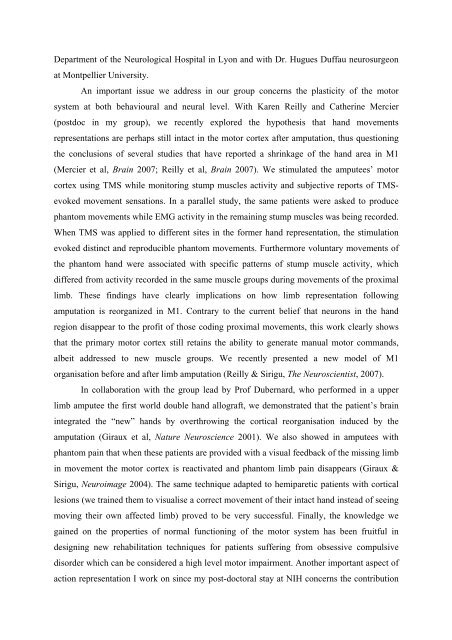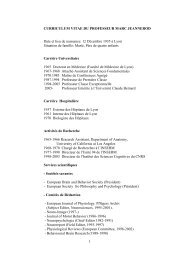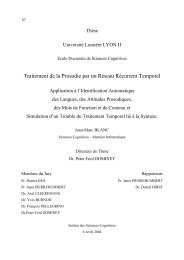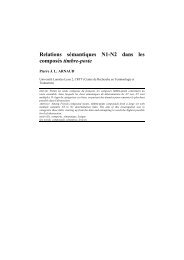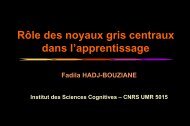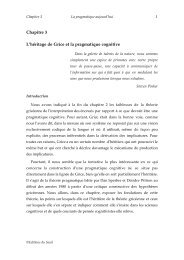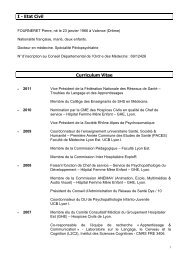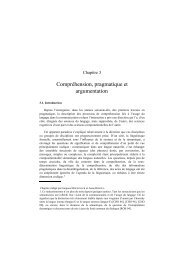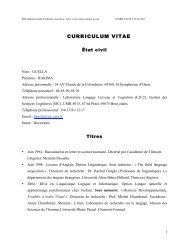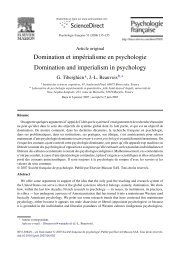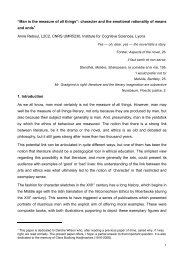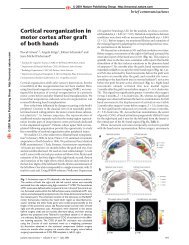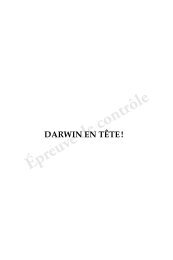curriculum vitae - CNC - Centre de Neurosciences Cognitives - CNRS
curriculum vitae - CNC - Centre de Neurosciences Cognitives - CNRS
curriculum vitae - CNC - Centre de Neurosciences Cognitives - CNRS
- No tags were found...
Create successful ePaper yourself
Turn your PDF publications into a flip-book with our unique Google optimized e-Paper software.
Department of the Neurological Hospital in Lyon and with Dr. Hugues Duffau neurosurgeon<br />
at Montpellier University.<br />
An important issue we address in our group concerns the plasticity of the motor<br />
system at both behavioural and neural level. With Karen Reilly and Catherine Mercier<br />
(postdoc in my group), we recently explored the hypothesis that hand movements<br />
representations are perhaps still intact in the motor cortex after amputation, thus questioning<br />
the conclusions of several studies that have reported a shrinkage of the hand area in M1<br />
(Mercier et al, Brain 2007; Reilly et al, Brain 2007). We stimulated the amputees’ motor<br />
cortex using TMS while monitoring stump muscles activity and subjective reports of TMSevoked<br />
movement sensations. In a parallel study, the same patients were asked to produce<br />
phantom movements while EMG activity in the remaining stump muscles was being recor<strong>de</strong>d.<br />
When TMS was applied to different sites in the former hand representation, the stimulation<br />
evoked distinct and reproducible phantom movements. Furthermore voluntary movements of<br />
the phantom hand were associated with specific patterns of stump muscle activity, which<br />
differed from activity recor<strong>de</strong>d in the same muscle groups during movements of the proximal<br />
limb. These findings have clearly implications on how limb representation following<br />
amputation is reorganized in M1. Contrary to the current belief that neurons in the hand<br />
region disappear to the profit of those coding proximal movements, this work clearly shows<br />
that the primary motor cortex still retains the ability to generate manual motor commands,<br />
albeit addressed to new muscle groups. We recently presented a new mo<strong>de</strong>l of M1<br />
organisation before and after limb amputation (Reilly & Sirigu, The Neuroscientist, 2007).<br />
In collaboration with the group lead by Prof Dubernard, who performed in a upper<br />
limb amputee the first world double hand allograft, we <strong>de</strong>monstrated that the patient’s brain<br />
integrated the “new” hands by overthrowing the cortical reorganisation induced by the<br />
amputation (Giraux et al, Nature Neuroscience 2001). We also showed in amputees with<br />
phantom pain that when these patients are provi<strong>de</strong>d with a visual feedback of the missing limb<br />
in movement the motor cortex is reactivated and phantom limb pain disappears (Giraux &<br />
Sirigu, Neuroimage 2004). The same technique adapted to hemiparetic patients with cortical<br />
lesions (we trained them to visualise a correct movement of their intact hand instead of seeing<br />
moving their own affected limb) proved to be very successful. Finally, the knowledge we<br />
gained on the properties of normal functioning of the motor system has been fruitful in<br />
<strong>de</strong>signing new rehabilitation techniques for patients suffering from obsessive compulsive<br />
disor<strong>de</strong>r which can be consi<strong>de</strong>red a high level motor impairment. Another important aspect of<br />
action representation I work on since my post-doctoral stay at NIH concerns the contribution


